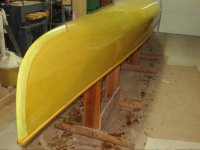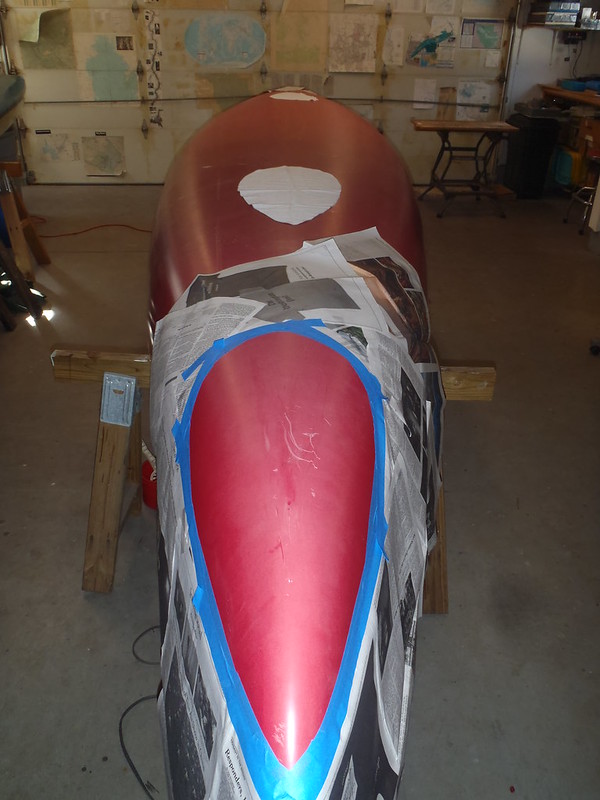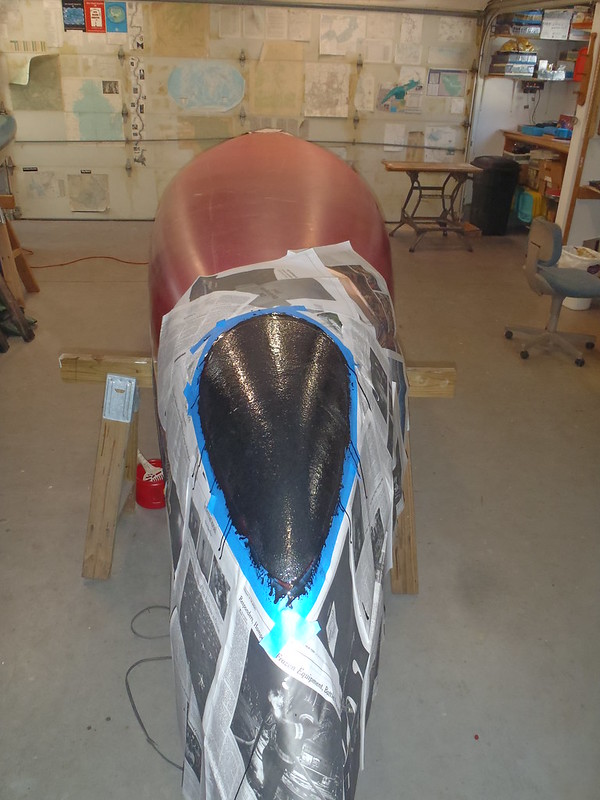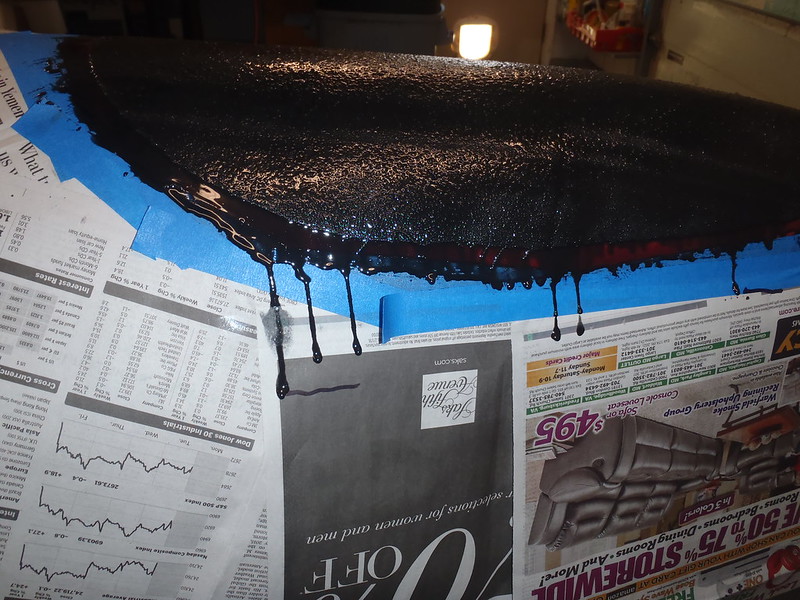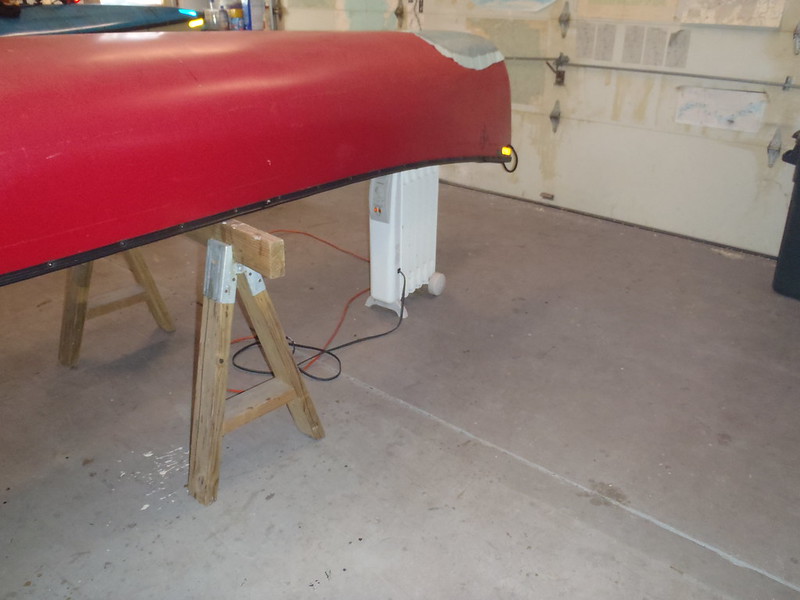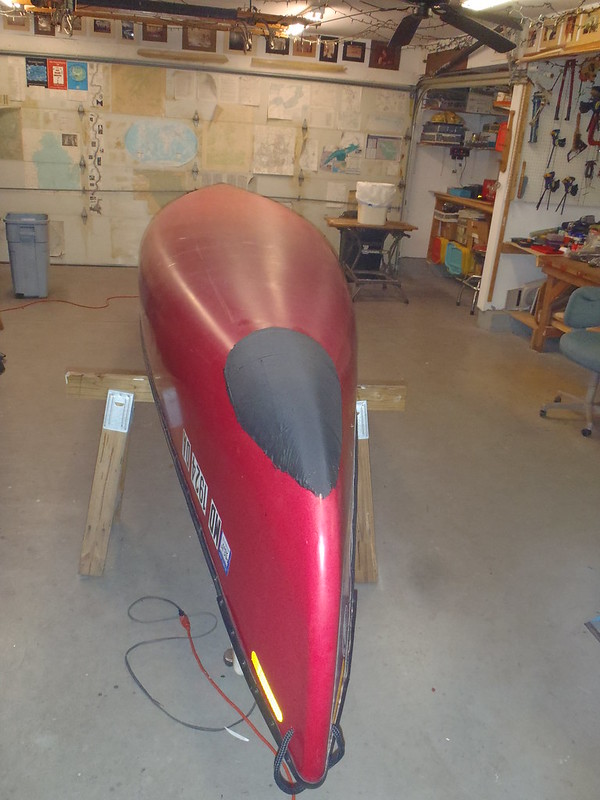Dynel skid plate installation.
Also copied and corrected from another post. And added to, I am still learning about Dynel and peel ply work. Most recently, cut the peel ply
two inches larger than the Dynel, and using a red hot knife blade to cut Dynel is really
not a good idea.
If you opt to go Dynel, Gflex and peel ply I will offer my installation method. I do not remove the ABS layer as is sometimes suggested, and at most do a light sanding 220 sanding to remove any gloss that remains on gel coated hulls. The Gflex prep chart shows a simple alcohol wipe and flame treat as having the highest tensile adhesion for ABS hulls.
https://www.westsystem.com/specialty-epoxies/gflex-epoxy-adhesion-data/
Clean the stems with alcohol. I wash the whole boat first, mostly because I do not like working on a dirty hull and possibly transferring contaminates onto the hull area in question, and also because detail washing is a good way to get up close and personal with a boat, and often find other areas in need of attention.
Alcohol wipe the stems and beyond where the skid plate will be installed.
Design the length, width and shape of the Dynel skid plates.
Cut that Dynel shape. It helps to make a paper template and transfer that pattern to the Dynel. Dynel cuts with a fairly clean edge using scissors or a razor blade. Do not reproduce the experiment we tried this fall and use a red hot knife edge, that just made an unholy mess, and turned the edge of the Dynel purple.
You can opt to cut Dynel on the bias and it will better conform to complex curves, but that wastes a lot of Dynel fabric. I am cheap, and release treated peel ply flattens the unbiased edge wrinkles, so I cut the Dynel in the most fabric economical way.
While you have that cut Dynel out lay it atop the peel ply and trace and cut the peel ply about 2 inches larger all around. All of the fabric materials are now ready.
Lay that Dynel shape on the stem and tape out a perimeter on the stem about a quarter inch away, all the way around. I use blue painters tape for a clean edge.
I admittedly spend an inordinate amount of time taping and papering a hull. I can be drippy sloppy and sometimes over generous with the resin. Using peel ply helps evenly spread and level my over generous resin applications.
Once that perimeter tape is in place I use little pieces of Scotch tape to adhere sheets of newspaper half way up the blue perimeter tape, and then lap that edge with another perimeter of tape so the resin can not drip down under the newspaper.
You will need to cut the newspaper at the stem tip into a curve. I just hold the paper up, roughly pencil mark a curve line on the newspaper edge and round that corner off. It does not need to be precise since the second perimeter of tape will cover any slight scissor curved misshape.
Mix your pot of resin. I economize with a 50 50 mix of West epoxy and Gflex, but straight Gflex would be better and require fewer materials purchased. Warm the Gflex bottles first, it is more viscous than regular epoxy resin. I do not mind the look of opaque black skid plates, so I add graphite powder and a dab of black resin.
Flame treat that skid plate area with a brief pass of a propane torch. Yes, you can do this with the tape and newspaper in place. The tape will withstand a brief pass of blue flame tongue and it is best to do that flame treatment immediately before resin application.
Press the tape down one more time with your thumb all the way around, just to be sure it is all still well adhered on the hull, with no gaps or lifts for the epoxy to drip down through.
Paint on a coat of epoxy resin inside the taped skid plate area.
Lay the Dynel atop that as carefully and smoothly as possible and top coat it with more resin. Dab at the edges until you realize you are doing more harm than good.
Walk away.
Watch the excess epoxy drip down the newspapered edges. When those drips seem to have stopped remove the outer tape layer and newspaper. I mark the bottom of a few drips with a Sharpie on the newspaper, when the drips stop running past the Sharpie hash marks it is OK to remove the newspaper and second applied layer of tape. If you thought ahead and left little foldover tabs on the tape this will be easy.
Walk away, but not far. Are the epoxy drips still creeping down the remaining perimeter tape? Egads, do not let them drip onto the unpapered hull. You can fold up the bottom edge of the tape to contain them, or hit the drips with the brush. Have a can of acetone and a rag available is a good thing when doing
any epoxy work.
When you judge those drips on the primary tape layer to have stopped creeping, pull that remaining layer of tape. Again, having folded little tab ends on the tape helps.
I take the tape off before the peel ply goes on, because I do not want to risk epoxying the painters tape to the hull. There may be a trick to leaving the tape in place that I do not yet know.
The resin and cloth are still tacky and compressible, and have not yet swollen like cured epoxy Dynel. BTW, epoxied Dynel without peel ply is rough textured and swells, someone once said, as thick as an old sweatshirt. Do not want either. Peel ply will resolve both issues, and will also level out uneven epoxy application.
Lay the release treated peel ply over the Dynel and epoxy. Carefully and smoothly, leaving some overlap all the way around, hence the 2 inches larger piece of peel ply, just in case your placement atop the still tacky epoxy is a little off kilter.
Press the peel ply into the Dynel. I finally broke my small hard plastic roller, but a disposable gloved hand works just as well.
Walk away, but not too far. In half an hour or so come back to the hull and press the peel ply down again, especially any raised areas, bubble or voids that are visible under the peel ply.
Repeat every 30 minutes for a couple hours, especially the edges. With the Dynel compressed as the epoxy sets up even the transition edge will largely disappear.
Walk away for the night. God bless release treated peel ply. The first time you remove peel ply from day old resin will be a fingers crossed and saying prayers moment. It need not be; the release treated peel ply will pull off like a Postit note.
The resin edge will be a little smushy indistinct from compressing the peel ply. No worries, most epoxy resins do not fare well in sun exposure over time without some UV inhibitor top coat, especially if you store your boats outside.
I use cheap Rustoleum enamel paint or etc as a UV topcoat. There are more expensive and more durable epoxy paint products.
If you want the underlying fabric to match the hull you can add a drop of pigment to the epoxy resin mix. The pigmented resin will deeply saturate the cloth, and when you scrape and scratch the paint topcoat the underlying color match will not show through as badly.
Wait at least a few days for the epoxy to outgas. A week is better. Wash to remove any amine blush. Tape and paper the canoe as before. Paint the skid plates in your color choice. Pull the painters tape as soon as you are done painting for a nice clean edge line. In a couple years, when you have binged some rocks and dragged the stems, tape it up and spray it again if aesthetically need be.
Yeah, that sounds laborious, but even with the prep time spent protectively taping and papering the hull it is only a couple or three hours spread over two days, and the Dynel and peel ply result is well worth the effort.

